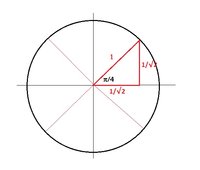Oliver Curtis
New member
- Joined
- Sep 11, 2020
- Messages
- 3
Hi Guys - any help here would be appreciated:
there is this question on uni prep work and I cant seem to crack the structure of the triangle they want:
Special angles whose trigonometric functions should be known are: π/ 6 , π/ 4 , π/ 3 . The trigonometric functions of these angles can be derived from studying an equilateral triangle (drop a line from one vertex to the midpoint of the facing side, this gives a right angled triangle with angles π/6 and π/3) and a right angled isosceles triangle. Derive the sine, cosine and tangent of these three important angles. These results can be easily checked (revision link).
My problem is that it is obvious all the angles are supposed to equal Pi over Three but then the isosceles doesn't add up to pi (180). Do all the angles have to be equal for an equilateral triangle. Also which two sides are equal on the isosceles - it cant be the hypotenuse and the adjacent because the adjacent is half one side of the whole bigger triangle and the hypotenuse is a whole side of the bigger triangle. Plus it doesnt make sense with pythagoras. I know the hypotenuse being root 2 is pythagoras' constant.
Thanks
Oliver
there is this question on uni prep work and I cant seem to crack the structure of the triangle they want:
Special angles whose trigonometric functions should be known are: π/ 6 , π/ 4 , π/ 3 . The trigonometric functions of these angles can be derived from studying an equilateral triangle (drop a line from one vertex to the midpoint of the facing side, this gives a right angled triangle with angles π/6 and π/3) and a right angled isosceles triangle. Derive the sine, cosine and tangent of these three important angles. These results can be easily checked (revision link).
My problem is that it is obvious all the angles are supposed to equal Pi over Three but then the isosceles doesn't add up to pi (180). Do all the angles have to be equal for an equilateral triangle. Also which two sides are equal on the isosceles - it cant be the hypotenuse and the adjacent because the adjacent is half one side of the whole bigger triangle and the hypotenuse is a whole side of the bigger triangle. Plus it doesnt make sense with pythagoras. I know the hypotenuse being root 2 is pythagoras' constant.
Thanks
Oliver

